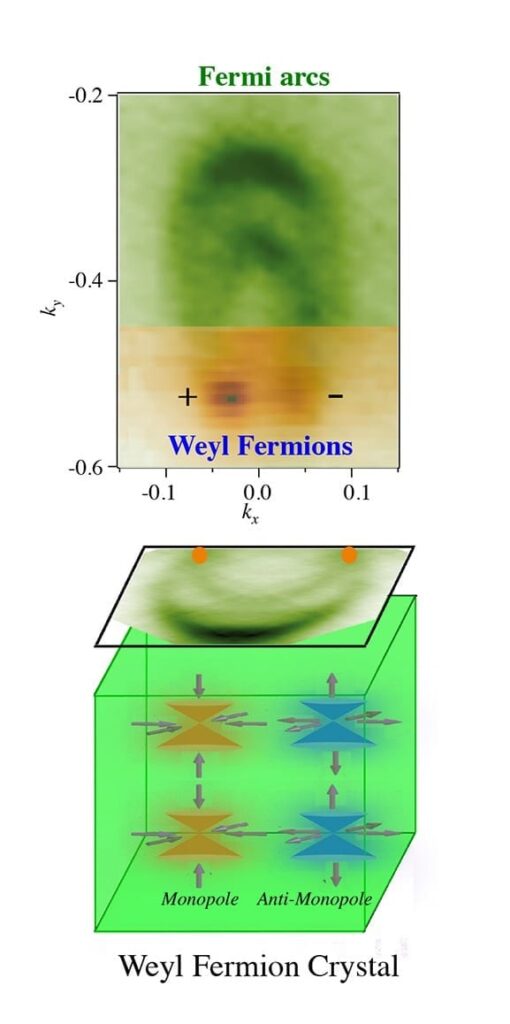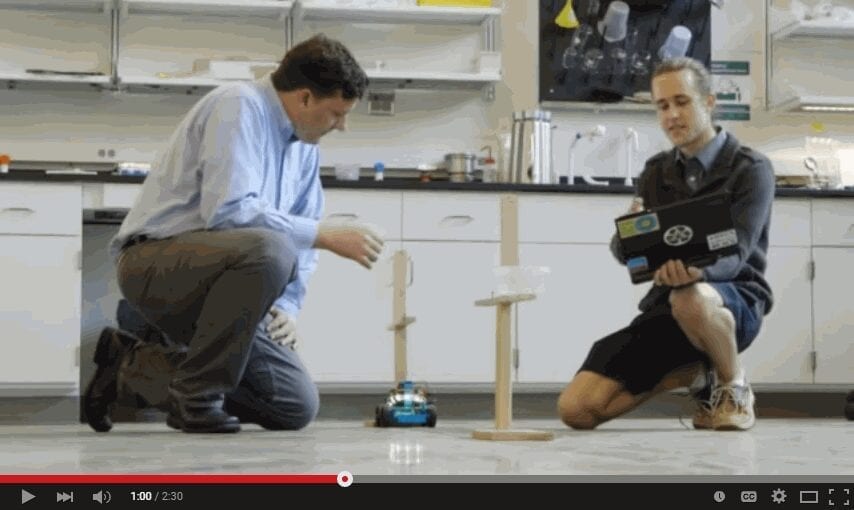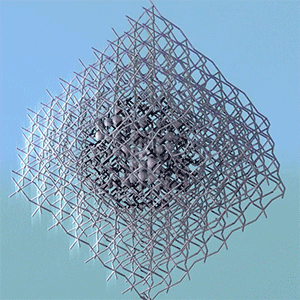
An international team led by Princeton University scientists has discovered an elusive massless particle theorized 85 years ago. The particle could give rise to faster and more efficient electronics because of its unusual ability to behave as matter and antimatter inside a crystal, according to new research.
The researchers report in the journal Science July 16 the first observation of Weyl fermions, which, if applied to next-generation electronics, could allow for a nearly free and efficient flow of electricity in electronics, and thus greater power, especially for computers, the researchers suggest.
Proposed by the mathematician and physicist Hermann Weyl in 1929, Weyl fermions have been long sought by scientists because they have been regarded as possible building blocks of other subatomic particles, and are even more basic than the ubiquitous, negative-charge carrying electron (when electrons are moving inside a crystal). Their basic nature means that Weyl fermions could provide a much more stable and efficient transport of particles than electrons, which are the principle particle behind modern electronics. Unlike electrons, Weyl fermions are massless and possess a high degree of mobility; the particle’s spin is both in the same direction as its motion — which is known as being right-handed — and in the opposite direction in which it moves, or left-handed.
“The physics of the Weyl fermion are so strange, there could be many things that arise from this particle that we’re just not capable of imagining now,” said corresponding author M. Zahid Hasan, a Princeton professor of physics who led the research team.
The researchers’ find differs from the other particle discoveries in that the Weyl fermion can be reproduced and potentially applied, Hasan said. Typically, particles such as the famous Higgs boson are detected in the fleeting aftermath of particle collisions, he said. The Weyl fermion, however, was discovered inside a synthetic metallic crystal called tantalum arsenide that the Princeton researchers designed in collaboration with researchers at the Collaborative Innovation Center of Quantum Matter in Beijing and at National Taiwan University.
The Weyl fermion possesses two characteristics that could make its discovery a boon for future electronics, including the development of the highly prized field of efficient quantum computing, Hasan explained.
For a physicist, the Weyl fermions are most notable for behaving like a composite of monopole- and antimonopole-like particles when inside a crystal, Hasan said. This means that Weyl particles that have opposite magnetic-like charges can nonetheless move independently of one another with a high degree of mobility.
The researchers also found that Weyl fermions can be used to create massless electrons that move very quickly with no backscattering, wherein electrons are lost when they collide with an obstruction. In electronics, backscattering hinders efficiency and generates heat. Weyl electrons simply move through and around roadblocks, Hasan said.
“It’s like they have their own GPS and steer themselves without scattering,” Hasan said. “They will move and move only in one direction since they are either right-handed or left-handed and never come to an end because they just tunnel through. These are very fast electrons that behave like unidirectional light beams and can be used for new types of quantum computing.”
Read more: After 85-year search, massless particle with promise for next-generation electronics discovered
The Latest on: Weyl fermions
[google_news title=”” keyword=”Weyl fermions” num_posts=”10″ blurb_length=”0″ show_thumb=”left”]
via Google News
The Latest on: Weyl fermions
- Quantum sensors see Weyl photocurrents flowon April 20, 2024 at 5:00 pm
Quantum sensors can be used to reveal a surprising new mechanism for converting light into electricity in Weyl semimetals, Boston College Assistant Professor of Physics Brian Zhou and colleagues ...
- A universal path for converting light into current in solidson April 15, 2024 at 5:00 pm
Photocurrent generation from Weyl semimetals are a hot topic due to their topological nature. Though Weyl semimetal provide robustness to external perturbations, photocurrent has only been ...
- Heat capacity measurements reveal Majorana fermionson April 7, 2024 at 5:00 pm
In the lab The evidence for Majorana fermions appeared in the thermodynamic behaviour of a so-called Kitaev magnet. (Courtesy: T Shibauchi) Researchers in Japan and Korea claim to have found ...
- - Quantum Motor Is a Revolution: Designed to Operate Without Electricity or Fuelon January 29, 2024 at 4:13 am
These belong either to the group of bosons or to the fermions, which form matter. Fermions include electrons and quarks, the basic building blocks of atoms. These tend to repel each other ...
- Understanding Weyl Semimetals: A Gateway to Novel Quantum Phenomenaon October 11, 2021 at 4:02 am
These nodes occur in pairs with opposite chirality, leading to nontrivial topological properties. The existence of Weyl fermions in these materials was predicted on theoretical grounds and has been ...
- Tom Weylon August 20, 2020 at 8:39 pm
Thomas J. Weyl is managing director and head of New Business Development of National Public Finance Guarantee Corporation. He is responsible for leading National’s marketing and new business ...
- The Standard Model Fermionson July 25, 2020 at 9:11 pm
However the full set of matter particles is the fermions. This has a much greater variety of sub-atomic particles. Some of these rarely exist outside of particle accelerators or major astronomical ...
- Hermann Weylon October 25, 2019 at 3:12 am
Hermann Weyl explores the concept of symmetry beginning with the idea that it represents... Read More View Book Add to Cart Philosophy of Mathematics and Natural Science Hermann Weyl When ...
- Thomas Weylon January 9, 2018 at 4:03 pm
Thomas J. Weyl is managing director and head of New Business Development of National Public Finance Guarantee Corporation. He is responsible for leading National s marketing and new business ...
via Bing News











